The Influence of Web Holes on the Behaviour of Cold-Formed Steel Members: A Review
Abstract
:1. Introduction
- To provide an overview of the existing research and knowledge on CFS members with web holes subjected to compression, bending, web crippling and shear;
- To summarise the chronological development and up-to-date design recommendations in one place;
- To point out the courses of future work and cases which might be examined in more detail.
2. Method
- Papers published as journal articles and conference papers;
- Papers published in the field of civil and structural engineering;
- Papers accessible in full-text.
- Duplicates;
- Papers not written in English;
- Papers published before 2010;
- Papers in which members were subjected to thermal load.
3. Design Codes and Theory
3.1. Design Codes
3.2. Numerical Solutions
4. Pure Compression
4.1. C-Section Stub Columns
4.2. C-Section Intermediate-Length Columns
4.3. C-Section Columns with Edge-Stiffened Web Holes
4.4. Other Sections
4.5. Comparisons and Discussion
5. Bending
5.1. C-Section Beams
5.2. C-Section Beams with Edge-Stiffened Web Holes
5.3. C-Section Beams with Web Reinforcement
5.4. Comparison and Discussion
6. Web Crippling
6.1. C-Sections
6.2. C-Sections with Edge-Stiffened Web Holes
6.3. Comparisons and Discussion
7. Shear
7.1. C-Sections
7.2. C-Section Beams with Web Reinforcement
7.3. Comparisons and Discussion
8. Conclusions
Author Contributions
Funding
Conflicts of Interest
Nomenclature
| A0 | gross cross-section area |
| Af | flange area |
| Ah | hole area |
| As | area of the opening |
| Aw | web area |
| b | horizontal width of a rectangular opening |
| Cw,net | warping stiffness of the net section |
| d | circular hole diameter or the square hole size |
| E | Young’s modulus of elasticity |
| EIweb | flexural stiffness of the web |
| GJf | torsional stiffness of the rectangular hollow flange |
| h | flat height of the web |
| hs | web stiffener height |
| Ig | moment of inertia of the gross cross section |
| Inet | moment of inertia of the net cross-section at a hole |
| Javg | St. Venant torsional constant including the influence of holes |
| k0 | shear buckling coefficient of the member without the hole |
| kv | shear buckling coefficient for the member with the hole |
| L | member length/span (Lg + Lnet) |
| Lg | length of the portion of column without holes |
| Lnet | length of the portion of column with holes |
| Mcrd | critical elastic distortional buckling moment |
| Mcrd-h | critical elastic distortional buckling moment including the influence of holes |
| Mcrd-nh | critical elastic distortional buckling moment without the influence of holes |
| Mcre-h | critical elastic lateral–torsional buckling moment including the influence of holes |
| Mcrl-h | critical elastic local buckling moment including the influence of holes |
| Mcrl-nh | critical elastic local buckling moment without the influence of holes |
| Mnd | nominal flexural strength for distortional buckling |
| Mne | nominal flexural strength for lateral–torsional buckling |
| Mnl | nominal flexural strength for local buckling |
| Mpv | plastic bending moment capacity of the top (or bottom) segment above (or below) the opening (including the flanges and the lips) |
| Mu | nominal flexural strength |
| My | member yield moment |
| Myn | member yield moment of net cross-section |
| N | length of bearing plate |
| n | effective length of the load (support) plate |
| Pcrd | critical elastic buckling load for distortional buckling |
| Pcrd-h | critical elastic buckling load for distortional buckling for member with holes |
| Pcrd-nh | critical elastic buckling load for distortional buckling for member without holes |
| Pcre-h | critical elastic buckling load for global buckling for member with holes |
| Pcrl | critical elastic buckling load for local buckling |
| Pcrl-h | critical elastic buckling load for local buckling for member with holes |
| Pcrl-nh | critical elastic buckling load for local buckling for member without holes |
| PMS | compression resistance of the member with web holes predicted from [5] |
| Pnd | nominal axial resistance for distortional buckling |
| Pne | nominal axial resistance for overall buckling |
| Pnle | nominal axial resistance for local buckling |
| Pprop | compression resistance of the member with web holes |
| Pult | compression resistance of the member with web holes |
| Py | axial yield load |
| Pyn | member yield strength on net cross-section |
| q | length of the web hole’s edge-stiffener |
| qs | shear strength reduction factor |
| Rp | proposed web crippling strength reduction factor |
| rq | inside corner radius between the web and the hole’s edge-stiffener |
| S | hole spacing |
| s | clear hole spacing |
| t | web thickness |
| tequ | equivalent thickness |
| tf | flange thickness |
| V1, V2 | shear forces at each edge of the hole |
| Vn | nominal shear resistance per web in accordance with [126] |
| Vnl | reduced shear capacity for a member with a hole |
| Vv | shear capacity for the member without the hole |
| Vvrd | shear carried out over the opening based on the Vierendel mechanism |
| Vvrd,0.6 | shear carried out over the opening based on the Vierendel mechanism calculated for the member with holes with the ratio d/h = 0.6 |
| Vvrd,m | shear carried out over the opening based on the Vierendel mechanism calculated for the member with holes with the ratio dh/h = m |
| Vy | yield shear load for the member without holes |
| Vyh | yield shear load for the member with holes |
| x | horizontal clear distance of web holes to the bearing plate edge |
Appendix A
| Reference | Equation | Note |
|---|---|---|
| Shanmugam and Dhanalakshmi [40] | ||
| Moen and Schafer [5], design option 4 | flexural, torsional or torsional–flexural buckling | |
| local buckling | ||
| distortional buckling | ||
| Yao and Rasmussen [12], proposed method 1 | flexural, torsional or torsional–flexural buckling | |
| local buckling | ||
| distortional buckling | ||
| Chen et al. [14] (columns with edge-stiffened holes) | ||
| Grey and Moen [4] (columns with edge-stiffened holes) | global flexural buckling | |
| flexural–torsional buckling | ||
| distortional buckling | ||
| local buckling |
| Reference | Equation | Note |
|---|---|---|
| Wang and Young [18] | built-up sections, local buckling | |
| Zhao et al. [21] | local buckling | |
| distortional buckling | ||
| Grey and Moen [4] (beams with edge-stiffened holes) | lateral–torsional buckling | |
| distortional buckling | ||
| Yu [28] (beams with edge-stiffened holes) | local buckling | |
| Reference | Equation | Note |
|---|---|---|
| Davis and Yu [59] | for circular holes: | ITF |
| for square holes: | ||
| Uzzaman et al. [48] | for unfastened flanges: | ITF |
| for fastened flanges: | ||
| Uzzaman et al. [50] | for unfastened flanges: | ITF |
| for fastened flanges: | ||
| Yousefi et al. [58] | centred web holes: | ITF |
| for unfastened flanges: | ||
| for fastened flanges: | ||
| offset web holes: | ||
| for unfastened flanges: | ||
| for fastened flanges: | ||
| Uzzaman et al. [35] | centred web holes: | ITF, edge–stiffened holes |
| offset web holes: | ||
| Sivakumaran and Zielonka [60] | IOF | |
| Langan et al. [61] | IOF | |
| Lian et al. [55] | centred web holes: | IOF |
| for unfastened flanges: | ||
| for fastened flanges: | ||
| offset web holes: | ||
| for unfastened flanges: | ||
| for fastened flanges: | ||
| Langan et al. [61] | EOF | |
| Lian et al. [53] | centred web holes: | EOF |
| for unfastened flanges: | ||
| for fastened flanges: | ||
| offset web holes: | ||
| for unfastened flanges: | ||
| for fastened flanges: | ||
| Uzzaman et al. [50] | for unfastened flanges: | ETF |
| for fastened flanges: | ||
| Uzzaman et al. [51] | for unfastened flanges: | ETF |
| for fastened flanges: | ||
| Uzzaman et al. [34] | centred web holes: | ETF, edge–stiffened holes |
| offset web holes: | ||
| Reference | Equation | Note |
|---|---|---|
| Eiler et al. [66] | ||
| , for | ||
| , for | ||
| , for | ||
| , for | ||
| , for circular holes | ||
| , for square holes | ||
| C.H. Pham [43] | circular holes: | |
| , for | ||
| , for | ||
| , for | ||
| square holes: | ||
| , for | ||
| , for | ||
| , for | ||
| Keerthan and Mahendran [67] | ||
| option 1: | ||
| , for | ||
| , for | ||
| , for | ||
| option 2: | ||
| , for | ||
| , for | ||
| S.H. Pham [44] | , for | |
| , for | ||
| , for | ||
| D.K. Pham et al. [45] | , for | |
| , for | ||
| , for | ||
| , | ||
| C.H. Pham and Hancock [46] | , for | |
| , for | ||
| , for | ||
References
- Yu, W.; Davis, C.S. Buckling Behavior and Post-Buckling Strength of Perforated Stiffened Compression Elements. In Proceedings of the International Specialty Conference on Cold-Formed Steel Structures, Rolla, MI, USA, 19–20 August 1971. [Google Scholar]
- Moen, C.D.; Schafer, B.W. Experiments on Cold-Formed Steel Columns with Holes. Thin-Walled Struct. 2008, 46, 1164–1182. [Google Scholar] [CrossRef]
- Moen, C.D.; Schafer, B.W. Elastic Buckling of Cold-Formed Steel Columns and Beams with Holes. Eng. Struct. 2009, 31, 2812–2824. [Google Scholar] [CrossRef]
- Grey, C.N.; Moen, C.D. Elastic Buckling Simplified Methods for Cold-Formed Columns and Beams with Edge-Stiffened Holes. In Proceedings of the Annual Stability Conference Structural Stability Research Council Pittsburgh, Pittsburgh, PA, USA, 10–14 May 2011; pp. 92–103. [Google Scholar]
- Moen, C.D.; Schafer, B.W. Direct Strength Method for Design of Cold-Formed Steel Columns with Holes. J. Struct. Eng. 2011, 137, 559–570. [Google Scholar] [CrossRef]
- Kulatunga, M.P.; Macdonald, M. Investigation of Cold-Formed Steel Structural Members with Perforations of Different Arrangements Subjected to Compression Loading. Thin-Walled Struct. 2013, 67, 78–87. [Google Scholar] [CrossRef]
- Smith, F.H.; Moen, C.D. Finite Strip Elastic Buckling Solutions for Thin-Walled Metal Columns with Perforation Patterns. Thin-Walled Struct. 2014, 79, 187–201. [Google Scholar] [CrossRef]
- Kulatunga, M.P.; Macdonald, M.; Rhodes, J.; Harrison, D.K. Load Capacity of Cold-Formed Column Members of Lipped Channel Cross-Section with Perforations Subjected to Compression Loading—Part I: FE Simulation and Test Results. Thin-Walled Struct. 2014, 80, 1–12. [Google Scholar] [CrossRef]
- Wang, C.; Zhang, Z.; Zhao, D.; Bai, Y. Experimental and Numerical Study on Perforated Channel Columns with Complex Edge Stiffeners and Web Stiffeners. Adv. Struct. Eng. 2015, 18, 1303–1318. [Google Scholar] [CrossRef]
- Wang, C.; Bai, Y.; Liu, Q.; Zhao, D. Stability Behavior of Perforated Lipped Channel Columns. In Proceedings of the MATEC Web of Conferences, Hong Kong, China, 11–12 June 2016; Volume 67. [Google Scholar]
- Yao, Z.; Rasmussen, K.J.R. Perforated Cold-Formed Steel Members in Compression. I: Parametric Studies. J. Struct. Eng. 2016, 143, 04016226. [Google Scholar] [CrossRef]
- Yao, Z.; Rasmussen, K.J.R. Perforated Cold-Formed Steel Members in Compression. II: Design. J. Struct. Eng. 2016, 143, 04016227. [Google Scholar] [CrossRef]
- Chen, B.; Roy, K.; Uzzaman, A.; Raftery, G.M.; Nash, D.; Clifton, G.C.; Pouladi, P.; Lim, J.B.P. Effects of Edge-Stiffened Web Openings on the Behaviour of Cold-Formed Steel Channel Sections under Compression. Thin-Walled Struct. 2019, 144, 106307. [Google Scholar] [CrossRef]
- Chen, B.; Roy, K.; Uzzaman, A.; Raftery, G.M.; Lim, J.B.P. Parametric Study and Simplified Design Equations for Cold-Formed Steel Channels with Edge-Stiffened Holes under Axial Compression. J. Constr. Steel Res. 2020, 172, 106161. [Google Scholar] [CrossRef]
- Chen, B.; Roy, K.; Uzzaman, A.; Raftery, G.M.; Lim, J.B.P. Axial Strength of Back-to-Back Cold-Formed Steel Channels with Edge-Stiffened Holes, Un-Stiffened Holes and Plain Webs. J. Constr. Steel Res. 2020, 174, 106313. [Google Scholar] [CrossRef]
- Xiang, Y.; Zhou, X.; Shi, Y.; Xu, L.; Xu, Y. Experimental Investigation and Finite Element Analysis of Cold-Formed Steel Channel Columns with Complex Edge Stiffeners. Thin-Walled Struct. 2020, 152, 106769. [Google Scholar] [CrossRef]
- Ling, J.Y.; Kong, S.L.; De’nan, F. Numerical Study of Buckling Behaviour of Cold-Formed C-Channel Steel Purlin with Perforation. Procedia Eng. 2015, 125, 1135–1141. [Google Scholar] [CrossRef] [Green Version]
- Wang, L.; Young, B. Design of Cold-Formed Steel Built-up Sections with Web Perforations Subjected to Bending. Thin-Walled Struct. 2017, 120, 458–469. [Google Scholar] [CrossRef]
- Yuan, W.-b.; Yu, N.-t.; Li, L.-y. Distortional Buckling of Perforated Cold-Formed Steel Channel-Section Beams with Circular Holes in Web. Int. J. Mech. Sci. 2017, 126, 255–260. [Google Scholar] [CrossRef] [Green Version]
- Yu, N.T.; Kim, B.; Yuan, W.-b.; Li, L.-y.; Yu, F. An Analytical Solution of Distortional Buckling Resistance of Cold-Formed Steel Channel-Section Beams with Web Openings. Thin-Walled Struct. 2019, 135, 446–452. [Google Scholar] [CrossRef]
- Zhao, J.; Sun, K.; Yu, C.; Wang, J. Tests and Direct Strength Design on Cold-Formed Steel Channel Beams with Web Holes. Eng. Struct. 2019, 184, 434–446. [Google Scholar] [CrossRef]
- Chen, B.; Roy, K.; Fang, Z.; Uzzaman, A.; Raftery, G.; Lim, J.B.P. Moment Capacity of Back-to-Back Cold-Formed Steel Channels with Edge-Stiffened Holes, Un-Stiffened Holes, and Plain Webs. Eng. Struct. 2021, 235, 112042. [Google Scholar] [CrossRef]
- Shan, M.-Y.; LaBoube, R. Behavior of Web Elements with Openings Subjected to Bending, Shear and the Combination of Bending and Shear; Department of Civil Engineering, University of Missouri-Rolla: Rolla, MI, USA, 1994. [Google Scholar]
- Shan, M.Y.; Batson, K.D.; LaBoube, R.A.; Yu, W.W. Local Buckling Flexural Strength of Webs with Openings. Eng. Struct. 1994, 16, 317–323. [Google Scholar] [CrossRef]
- Shan, M.Y.; LaBoube, R.A.; Yu, W.W. Bending and Shear Behavior of Web Elements with Openings. J. Struct. Eng. 1996, 122, 854–859. [Google Scholar] [CrossRef]
- Hancock, G.J. Design for Distortional Buckling of Flexural Members. Thin-Walled Struct. 1997, 27, 3–12. [Google Scholar] [CrossRef]
- Moen, C.D.; Schafer, B.W. Extending Direct Strength Design to Cold-Formed Steel Beams with Holes. In Proceedings of the 20th International Specialty Conference on Cold-Formed Steel Structures, St. Louis, MO, USA, 3–4 November 2010. [Google Scholar]
- Yu, C. Cold-Formed Steel Flexural Member with Edge Stiffened Holes: Behavior, Optimization, and Design. J. Constr. Steel Res. 2012, 71, 210–218. [Google Scholar] [CrossRef]
- Moen, C.D.; Schudlich, A.; Von Der Heyden, A. Experiments on Cold-Formed Steel C-Section Joists with Unstiffened Web Holes. J. Struct. Eng. 2013, 139, 695–704. [Google Scholar] [CrossRef]
- Wang, L.; Young, B. Beam Tests of Cold-Formed Steel Built-up Sections with Web Perforations. J. Constr. Steel Res. 2015, 115, 18–33. [Google Scholar] [CrossRef]
- Dai, Y.; Roy, K.; Fang, Z.; Chen, B.; Raftery, G.M.; Lim, J.B.P. A Novel Machine Learning Model to Predict the Moment Capacity of Cold-Formed Steel Channel Beams with Edge-Stiffened and Un-Stiffened w.Pdf. J. Build. Eng. 2022, 53, 104592. [Google Scholar] [CrossRef]
- Wang, C.; Guo, Q.; Zhang, Z.; Guo, Y. Experimental and Numerical Investigation of Perforated Cold-Formed Steel Built-up I-Section Columns with Web Stiffeners and Complex Edge Stiffeners. Adv. Struct. Eng. 2019, 22, 2205–2221. [Google Scholar] [CrossRef]
- Uzzaman, A.; Lim, J.B.P.; Nash, D.; Young, B. Effects of Edge-Stiffened Circular Holes on the Web Crippling Strength of Cold-Formed Steel Channel Sections under One-Flange Loading Conditions. Eng. Struct. 2017, 139, 96–107. [Google Scholar] [CrossRef] [Green Version]
- Uzzaman, A.; Lim, J.B.P.; Nash, D.; Roy, K. Cold-Formed Steel Channel Sections under End-Two-Flange Loading Condition: Design for Edge-Stiffened Holes, Unstiffened Holes and Plain Webs. Thin-Walled Struct. 2020, 147, 106532. [Google Scholar] [CrossRef]
- Uzzaman, A.; Lim, J.B.P.; Nash, D.; Roy, K. Web Crippling Behaviour of Cold-Formed Steel Channel Sections with Edge-Stiffened and Unstiffened Circular Holes under Interior-Two-Flange Loading Condition. Thin-Walled Struct. 2020, 154, 106813. [Google Scholar] [CrossRef]
- Chen, B.; Roy, K.; Fang, Z.; Uzzaman, A.; Chi, Y.; Lim, J.B.P. Web Crippling Capacity of Fastened Cold-Formed Steel Channels with Edge-Stiffened Web Holes, Un-Stiffened Web Holes and Plain Webs under Two-Flange Loading. Thin-Walled Struct. 2021, 163, 107666. [Google Scholar] [CrossRef]
- Loov, R. Local Buckling Capacity of C-Shaped Cold-Formed Steel Sections with Punched Webs. Can. J. Civ. Eng. 1984, 11, 1–7. [Google Scholar] [CrossRef]
- Pu, Y.; Godley, M.H.; Beale, R.G.; Lau, H.H. Prediction of Ultimate Capacity of Perforated Lipped Channels. J. Struct. Eng. 1999, 125, 510–514. [Google Scholar] [CrossRef]
- Abdel-Rahman, N.; Sivakumaran, K.S. Effective Design Width for Perforated Cold-Formed Steel Compression Members. Can. J. Civ. Eng. 1998, 25, 319–330. [Google Scholar] [CrossRef]
- Shanmugam, N.E.; Dhanalakshmi, M. Design for Openings in Cold-Formed Steel Channel Stub Columns. Thin-Walled Struct. 2001, 39, 961–981. [Google Scholar] [CrossRef]
- Yao, Z.; Rasmussen, K.J.R. Inelastic Local Buckling Behaviour of Perforated Plates and Sections under Compression. Thin-Walled Struct. 2012, 61, 49–70. [Google Scholar] [CrossRef]
- Yao, Z.; Rasmussen, K.J.R. Design of Perforated Thin-Walled Steel Columns; School of Civil Engineering, The University of Sydney: Sydney, Australia, 2014. [Google Scholar]
- Pham, C.H. Shear Buckling of Plates and Thin-Walled Channel Sections with Holes. J. Constr. Steel Res. 2017, 128, 800–811. [Google Scholar] [CrossRef]
- Pham, S.H. Design of Cold-Formed Steel Beams with Holes and Transverse Stiffeners in Shear; School of Civil Engineering, The University of Sydney: Sydney, Australia, 2018. [Google Scholar]
- Pham, D.K.; Pham, C.H.; Pham, S.H.; Hancock, G.J. Experimental Investigation of High Strength Cold-Formed Channel Sections in Shear with Rectangular and Slotted Web Openings. J. Constr. Steel Res. 2020, 165, 105889. [Google Scholar] [CrossRef]
- Pham, C.H.; Hancock, G.J. Shear Tests and Design of Cold-Formed Steel Channels with Central Square Holes. Thin-Walled Struct. 2020, 149, 106650. [Google Scholar] [CrossRef]
- LaBoube, R.A.; Yu, W.W.; Deshmukh, S.U.; Uphoff, C.A. Crippling Capacity of Web Elements with Openings. J. Struct. Eng. 1999, 125, 137–141. [Google Scholar] [CrossRef]
- Uzzaman, A.; Lim, J.B.P.; Nash, D.; Rhodes, J.; Young, B. Web Crippling Behaviour of Cold-Formed Steel Channel Sections with Offset Web Holes Subjected to Interior-Two-Flange Loading. Thin-Walled Struct. 2012, 50, 76–86. [Google Scholar] [CrossRef] [Green Version]
- Uzzaman, A.; Lim, J.B.P.; Nash, D.; Rhodes, J.; Young, B. Cold-Formed Steel Sections with Web Openings Subjected to Web Crippling under Two-Flange Loading Conditions—Part I: Tests and Finite Element Analysis. Thin-Walled Struct. 2012, 56, 38–48. [Google Scholar] [CrossRef] [Green Version]
- Uzzaman, A.; Lim, J.B.P.; Nash, D.; Rhodes, J.; Young, B. Cold-Formed Steel Sections with Web Openings Subjected to Web Crippling under Two-Flange Loading Conditions—Part II: Parametric Study and Proposed Design Equations. Thin-Walled Struct. 2012, 56, 79–87. [Google Scholar] [CrossRef] [Green Version]
- Uzzaman, A.; Lim, J.B.P.; Nash, D.; Rhodes, J.; Young, B. Effect of Offset Web Holes on Web Crippling Strength of Cold-Formed Steel Channel Sections under End-Two-Flange Loading Condition. Thin-Walled Struct. 2013, 65, 34–48. [Google Scholar] [CrossRef]
- Lian, Y.; Uzzaman, A.; Lim, J.B.P.; Abdelal, G.; Nash, D.; Young, B. Effect of Web Holes on Web Crippling Strength of Cold-Formed Steel Channel Sections under End-One-Flange Loading Condition—Part I: Tests and Finite Element Analysis. Thin-Walled Struct. 2016, 107, 443–452. [Google Scholar] [CrossRef] [Green Version]
- Lian, Y.; Uzzaman, A.; Lim, J.B.P.; Abdelal, G.; Nash, D.; Young, B. Effect of Web Holes on Web Crippling Strength of Cold-Formed Steel Channel Sections under End-One-Flange Loading Condition—Part II: Parametric Study and Proposed Design Equations. Thin-Walled Struct. 2016, 107, 489–501. [Google Scholar] [CrossRef] [Green Version]
- Lian, Y.; Uzzaman, A.; Lim, J.B.P.; Abdelal, G.; Nash, D.; Young, B. Web Crippling Behaviour of Cold-Formed Steel Channel Sections with Web Holes Subjected to Interior-One-Flange Loading Condition—Part I: Experimental and Numerical Investigation. Thin-Walled Struct. 2017, 111, 103–112. [Google Scholar] [CrossRef] [Green Version]
- Lian, Y.; Uzzaman, A.; Lim, J.B.P.; Abdelal, G.; Nash, D.; Young, B. Web Crippling Behaviour of Cold-Formed Steel Channel Sections with Web Holes Subjected to Interior-One-Flange Loading Condition—Part II: Parametric Study and Proposed Design Equations. Thin-Walled Struct. 2017, 114, 92–106. [Google Scholar] [CrossRef] [Green Version]
- Fang, Z.; Roy, K.; Liang, H.; Poologanathan, K.; Ghosh, K.; Mohamed, A.M.; Lim, J.B.P. Numerical Simulation and Design Recommendations for Web Crippling Strength of Cold-Formed Steel Channels with Web Holes under Interior-One-Flange Loading at Elevated Temperatures. Buildings 2021, 11, 666. [Google Scholar] [CrossRef]
- Yousefi, A.M.; Lim, J.B.P.; Charles Clifton, G. Cold-Formed Ferritic Stainless Steel Unlipped Channels with Web Openings Subjected to Web Crippling under Interior-Two-Flange Loading Condition—Part I: Tests and Finite Element Model Validation. Thin-Walled Struct. 2017, 116, 333–341. [Google Scholar] [CrossRef]
- Yousefi, A.M.; Lim, J.B.P.; Clifton, G.C. Cold-Formed Ferritic Stainless Steel Unlipped Channels with Web Openings Subjected to Web Crippling under Interior-Two-Flange Loading Condition—Part II: Parametric Study and Design Equations. Thin-Walled Struct. 2017, 116, 342–356. [Google Scholar] [CrossRef]
- Davis, C.S.; Yu, W.W. The Structural Behavior of Cold-Formed Steel Members with Perforated Elements; Department of Civil Engineering, University of Missouri-Rolla: Rolla, MI, USA, 1972. [Google Scholar]
- Sivakumaran, K.S.; Zielonka, K.M. Web Crippling Strength of Thin-Walled Steel Members with Web Opening. Thin-Walled Struct. 1989, 8, 295–319. [Google Scholar] [CrossRef]
- Langan, E.J.; LaBoube, R.A.; Yu, W. Structural Behavior of Perforated Web Elements of Cold-Formed Steel Flexural Members Subjected to Web Crippling and a Combination of Web Crippling and Bending; Department of Civil Engineering, University of Missouri-Rolla: Rolla, MI, USA, 1994. [Google Scholar]
- Deshmukh, S.U.; LaBoube, R.A.; Yu, W. Behavior of Cold-Formed Steel Web Elements with Web Openings Subjected to Web Crippling and a Combination of Bending and Web Crippling for Interior-One-Flange Loading; Department of Civil Engineering, University of Missouri-Rolla: Rolla, MI, USA, 1996. [Google Scholar]
- Uphoff, C.A.; LaBoube, R.A.; Yu, W. Structural Behavior of Circular Holes in Web Elements of Cold-Formed Steel Flexural Members Subjected to Web Crippling for End-One-Flange Loading; Department of Civil Engineering, University of Missouri-Rolla: Rolla, MI, USA, 1996. [Google Scholar]
- Fang, Z.; Roy, K.; Chi, Y.; Chen, B.; Lim, J.B.P. Finite Element Analysis and Proposed Design Rules for Cold-Formed Stainless Steel Channels with Web Holes under End-One-Flange Loading. Structures 2021, 34, 2876–2899. [Google Scholar] [CrossRef]
- Fang, Z.; Roy, K.; Uzzaman, A.; Lim, J.B.P. Numerical Simulation and Proposed Design Rules of Cold-Formed Stainless Steel Channels with Web Holes under Interior-One-Flange Loading. Eng. Struct. 2022, 252, 113566. [Google Scholar] [CrossRef]
- Eiler, M.; Laboube, R.; Yu, W. Behavior of Web Elements with Openings Subjected to Linearly Varying Shear; Department of Civil Engineering, University of Missouri-Rolla: Rolla, MI, USA, 1997. [Google Scholar]
- Keerthan, P.; Mahendran, M. Experimental Studies of the Shear Behaviour and Strength of Lipped Channel Beams with Web Openings. Thin-Walled Struct. 2013, 73, 131–144. [Google Scholar] [CrossRef] [Green Version]
- Keerthan, P.; Mahendran, M. Improved Shear Design Rules for Lipped Channel Beams with Web Openings. J. Constr. Steel Res. 2014, 97, 127–142. [Google Scholar] [CrossRef] [Green Version]
- Pham, S.H.; Pham, C.H.; Rogers, C.A.; Hancock, G.J. New Proposals for the Direct Strength Method of Design of Cold-Formed Steel Beams with Holes in Shear. In Proceedings of the Wei-Wen Yu International Specialty Conference on Cold-Formed Steel Structures 2018, St. Louis, MO, USA, 7–8 November 2018; pp. 191–207. [Google Scholar]
- Pham, S.H.; Pham, C.H.; Hancock, G.J. Experimental Study of Shear Strength of Cold-Formed Channels with an Aspect Ratio of 2.0. J. Constr. Steel Res. 2018, 149, 141–152. [Google Scholar] [CrossRef]
- Pham, S.H.; Pham, C.H.; Hancock, G.J. Direct Strength Method of Design for Channel Sections in Shear with Square and Circular Web Holes. J. Struct. Eng. 2017, 143, 1–8. [Google Scholar] [CrossRef]
- Pham, D.K.; Pham, C.H.; Hancock, G.J. Parametric Study for Shear Design of Cold-Formed Channels with Elongated Web Openings. J. Constr. Steel Res. 2020, 172, 106222. [Google Scholar] [CrossRef]
- Acharya, S.R.; Sivakumaran, K.S.; Young, B. Reinforcement Schemes for Cold-Formed Steel Joists with a Large Web Opening in Shear Zone—An Experimental Investigation. Thin-Walled Struct. 2013, 72, 28–36. [Google Scholar] [CrossRef]
- Madugula, M.K.S.; Ray, S.K. Ultimate Strength of Eccentrically Loaded Cold-Formed Angles. Can. J. Civ. Eng. 1984, 11, 225–233. [Google Scholar] [CrossRef]
- Wang, C.; Zhang, Z.; Zhao, D.; Liu, Q. Compression Tests and Numerical Analysis of Web-Stiffened Channels with Complex Edge Stiffeners. J. Constr. Steel Res. 2016, 116, 29–39. [Google Scholar] [CrossRef]
- Ma, J.-L.; Chan, T.-M.; Young, B. Investigation on Cold-Formed High Strength Steel Circular Hollow Sections under Combined Compression and Bending. In Proceedings of the Eurosteel 2017, Copenhagen, Denmark, 13–15 September 2017; Volume 1, pp. 3622–3630. [Google Scholar]
- Merkl, C.; Toffolon, A.; Taras, A. Experimental and Numerical Study of the Behaviour of Eccentrically Loaded Cold-Formed Channel Sections—Determination of an Optimal Load Eccentricity. In Proceedings of the Eurosteel 2017, Copenhagen, Denmark, 13–15 September 2017; Volume 1, pp. 1553–1562. [Google Scholar]
- Sadovský, Z.; Kriváček, J. Influence of Boundary Conditions and Load Eccentricity on Strength of Cold-Formed Lipped Channel Columns. Thin-Walled Struct. 2018, 131, 556–565. [Google Scholar] [CrossRef]
- Ghandi, E.; Niari, S.E. Flexural-Torsional Buckling of Cold-Formed Steel Columns with Arbitrary Cross-Section under Eccentric Axial Load. Structures 2020, 28, 2122–2134. [Google Scholar] [CrossRef]
- Meza, F.J.; Becque, J.; Hajirasouliha, I. Experimental Study of Cold-Formed Steel Built-up Columns. Thin-Walled Struct. 2020, 149, 106291. [Google Scholar] [CrossRef]
- Chen, M.T.; Young, B. Beam-Column Tests of Cold-Formed Steel Elliptical Hollow Sections. Eng. Struct. 2020, 210, 109911. [Google Scholar] [CrossRef]
- Peiris, M.; Mahendran, M. Behaviour of Cold-Formed Steel Lipped Channel Sections Subject to Eccentric Axial Compression. J. Constr. Steel Res. 2021, 184, 106808. [Google Scholar] [CrossRef]
- Zhang, J.-F.; Wang, B.; Wang, S.; Deng, E.-F.; Zhang, P.; Pang, S.-Y.; Wen, M.-G.; Ye, L.; Guo, X.-S.; Gao, J. Eccentric Compressive Distortional Buckling and Design of Non-Symmetric Cold-Formed Angular Column with Complex Edges. Thin-Walled Struct. 2021, 165, 107981. [Google Scholar] [CrossRef]
- Li, Q.-Y.; Young, B. Tests of Cold-Formed Steel Built-up Open Section Members under Eccentric Compressive Load. J. Constr. Steel Res. 2021, 184, 106775. [Google Scholar] [CrossRef]
- Bonada, J.; Pastor, M.M.; Roure, F.; Casafont, M. Distortional Influence of Pallet Rack Uprights Subject to Combined Compression and Bending. Structures 2016, 8, 275–285. [Google Scholar] [CrossRef] [Green Version]
- Bertocci, L.; Comparini, D.; Lavacchini, G.; Orlando, M.; Salvatori, L.; Spinelli, P. Experimental, Numerical, and Regulatory P-Mx-My Domains for Cold-Formed Perforated Steel Uprights of Pallet-Racks. Thin-Walled Struct. 2017, 119, 151–165. [Google Scholar] [CrossRef]
- Pastor, M.M.; Bonada, J.; Roure, F.; Casafont, M.; Somalo, M.R. Rack Uprights under Combined Compression and Bi-Axial Bending: Experimental Testing, Numerical Analysis and European Standard Approach. In Proceedings of the Eurosteel 2017, Copenhagen, Denmark, 13–15 September 2017; Volume 1, pp. 1609–1616. [Google Scholar]
- Orlando, M.; Lavacchini, G.; Ortolani, B.; Spinelli, P. Experimental Capacity of Perforated Cold-Formed Steel Open Sections under Compression and Bending. Steel Compos. Struct. 2017, 24, 201–211. [Google Scholar] [CrossRef]
- AISI S100-2016; North American Specification for the Design of Cold-Formed Steel Structural Members. American Iron and Steel Institute: Washington, DC, USA, 2016.
- EN 1993-1-3; Eurocode 3: Design of Steel Structures—Part 1–3: General Rules–Supplementary Rules for Cold-Formed Members and Sheeting. European Committee for Standardization: Brussels, Belgium, 2006.
- AS/NZS 4600: 2018; Cold-Formed Steel Structures. AustralianNew Zealand Standard: Sydney, Australia; Wellington, New Zealand, 2018.
- GB50018-2002; Technical Code of Cold-Formed Thin-Wall Steel Structures. General Administration of Quality Supervision Inspection and Quarantine: Beijing, China, 2002.
- American Iron and Steel Institute. Specification for the Design of Light Gage Steel Structural Members; American Iron and Steel Institute: New York, NY, USA, 1946. [Google Scholar]
- EN 15512; Steel Static Storage Systems-Adjustable Pallet Racking Systems-Principles for Structural Design. European Committee for Standardization: Brussels, Belgium, 2009.
- Dubina, D.; Ungureanu, V.; Landolfo, R. Design of Cold-Formed Steel Structures; European Convention for Constructional Steelwork: Brussels, Belgium, 2012; ISBN 978-92-9147-107-2. [Google Scholar]
- Ádány, S.; Silvestre, N.; Schafer, B.W.; Camotim, D. GBT and CFSM: Two Modal Approaches to the Buckling Analysis of Unbranched Thin-Walled Members. Adv. Steel Constr. 2009, 5, 195–223. [Google Scholar]
- Casafont, M.; Pastor, M.M.; Roure, F.; Bonada, J.; Peköz, T. Design of Steel Storage Rack Columns via the Direct Strength Method. J. Struct. Eng. 2013, 139, 669–679. [Google Scholar] [CrossRef]
- Li, Z.; Schafer, B.W. Constrained Finite Strip Method for Thin-Walled Members with General End Boundary Conditions. J. Eng. Mech. 2013, 139, 1566–1576. [Google Scholar] [CrossRef]
- Li, Z.; Schafer, B.W. Buckling Analysis of Cold-Formed Steel Members with General Boundary Conditions Using CUFSM: Conventional and Constrained Finite Strip Methods. In Proceedings of the 20th International Specialty Conference on Cold-Formed Steel Structures, St. Louis, MO, USA, 3–4 November 2010. [Google Scholar]
- Moen, C.D. Direct Strength Design of Cold-Formed Steel Members with Perforations. Ph.D. Dissertation, Johns Hopkins University, Baltimore, MD, USA, 2008. [Google Scholar]
- Abaqus/CAE User’s Guide, Ver. 6.14, Dassault Systèmes Simulia Corp.: Providence, RI, USA, 2014.
- Silvestre, N.; Camotim, D. First-Order Generalised Beam Theory for Arbitrary Orthotropic Materials. Thin-Walled Struct. 2002, 40, 755–789. [Google Scholar] [CrossRef]
- Silvestre, N.; Camotim, D. Second-Order Generalised Beam Theory for Arbitrary Orthotropic Materials. Thin-Walled Struct. 2002, 40, 791–820. [Google Scholar] [CrossRef]
- Abambres, M.; Camotim, D.; Silvestre, N. Modal Decomposition of Thin-Walled Member Collapse Mechanisms. Thin-Walled Struct. 2014, 74, 269–291. [Google Scholar] [CrossRef]
- Bebiano, R.; Basaglia, C.; Camotim, D.; Gonçalves, R. GBT Buckling Analysis of Generally Loaded Thin-Walled Members with Arbitrary Flat-Walled Cross-Sections. Thin-Walled Struct. 2018, 123, 11–24. [Google Scholar] [CrossRef]
- Bebiano, R.; Camotim, D.; Gonçalves, R. GBTUL 2.0—A Second-Generation Code for the GBT-Based Buckling and Vibration Analysis of Thin-Walled Members. Thin-Walled Struct. 2018, 124, 235–257. [Google Scholar] [CrossRef]
- S136-1974; Cold Formed Steel Structural Members. Canadian Standards Association: Rexadale, ON, Canada, 1974.
- Sivakumaran, K.S. Load Capacity of Uniformly Compressed Cold-Formed Steel Section with Punched Web. Can. J. Civ. Eng. 1987, 14, 550–558. [Google Scholar] [CrossRef]
- Sivakumaran, K.S. Some Studies on Cold-Formed Steel Sections with Web Openings. In Proceedings of the Ninth International Specialty Conference on Cold-Formed Steel Structures, St. Louis, MO, USA, 8–9 November 1988. [Google Scholar]
- AISI S100-1986; Specification for the Design of Cold-Formed Steel Structural Members Design. American Iron and Steel Institute: Washington, DC, USA, 1986.
- Abdel-Rahman, N. Cold-Formed Steel Compression Members with Perforations; McMaster University: Hamilton, ON, Canada, 1997. [Google Scholar]
- Yao, Z.; Rasmussen, K.J.R. Material and Geometric Nonlinear Isoparametric Spline Finite Strip Analysis of Perforated Thin-Walled Steel Structures—Analytical Developments. Thin-Walled Struct. 2011, 49, 1374–1391. [Google Scholar] [CrossRef]
- Yao, Z.; Rasmussen, K.J.R. Material and Geometric Nonlinear Isoparametric Spline Finite Strip Analysis of Perforated Thin-Walled Steel Structures—Numerical Investigations. Thin-Walled Struct. 2011, 49, 1359–1373. [Google Scholar] [CrossRef]
- AISI S100-2012; North American Specification for the Design of Cold-Formed Steel Structural Members. American Iron and Steel Institute: Washington, DC, USA, 2012.
- BS 5950-5:1998; Structural Use of Steelwork in Building—Part 5. Code of Practice for Design of Cold Formed Thin Gauge Sections. British Standards Institution: London, UK, 1998; ISBN 0580282481.
- Moen, C.D.; Schafer, B.W. Direct Strength Design of Cold-Formed Steel Members with Perforations; American Iron and Steel Institute: Washington, DC, USA, 2009. [Google Scholar]
- AISI S100-2007; North American Specification for the Design of Cold-Formed Steel Structural Members. American Iron and Steel Institute: Washington, DC, USA, 2007.
- Sivakumaran, K.S.; Ng, M.Y.; Fox, S.R. Flexural Strength of Cold-Formed Steel Joists with Reinforced Web Openings. Can. J. Civ. Eng. 2006, 33, 1195–1208. [Google Scholar] [CrossRef]
- AISI S100-1968; Specification for the Design of Cold-Formed Steel Structural Members. American Iron and Steel Institute: Charlotte, NC, USA, 1968.
- CAN3-S136-M84; Cold Formed Steel Structural Members. Canadian Standards Association: Rexadale, ON, Canada, 1984.
- Lau, S.C.W.; Hancock, G.J. Buckling of Thin Flat-Walled Structures by a Spline Finite Strip Method. Thin-Walled Struct. 1986, 4, 269–294. [Google Scholar] [CrossRef]
- AS/NZS4673 AS/NZS 4600:2005; Cold-Formed Steel Structures. Standards Australia/Standards New Zealand: Sydney, Australia, 2005.
- LaBoube, R.A.; Yu, W.W.; Langan, J.E.; Shan, M.Y. Cold-Formed Steel Webs with Openings: Summary Report. Thin-Walled Struct. 1997, 27, 79–84. [Google Scholar] [CrossRef]
- Chung, K.F.; Liu, T.C.H.; Ko, A.C.H. Investigation on Vierendeel Mechanism in Steel Beams with Circular Web Openings. J. Constr. Steel Res. 2001, 57, 467–490. [Google Scholar] [CrossRef]
- ANSI/AISC 360-16; Specification for Structural Steel Buildings. American Institute of Steel Construction: Chicago, IL, USA, 2016.
- American Iron and Steel Institute. Load and Resistance Factor Design Specification for Cold-Formed Steel Structural Members; American Iron and Steel Institute: Washington, DC, USA, 1991. [Google Scholar]


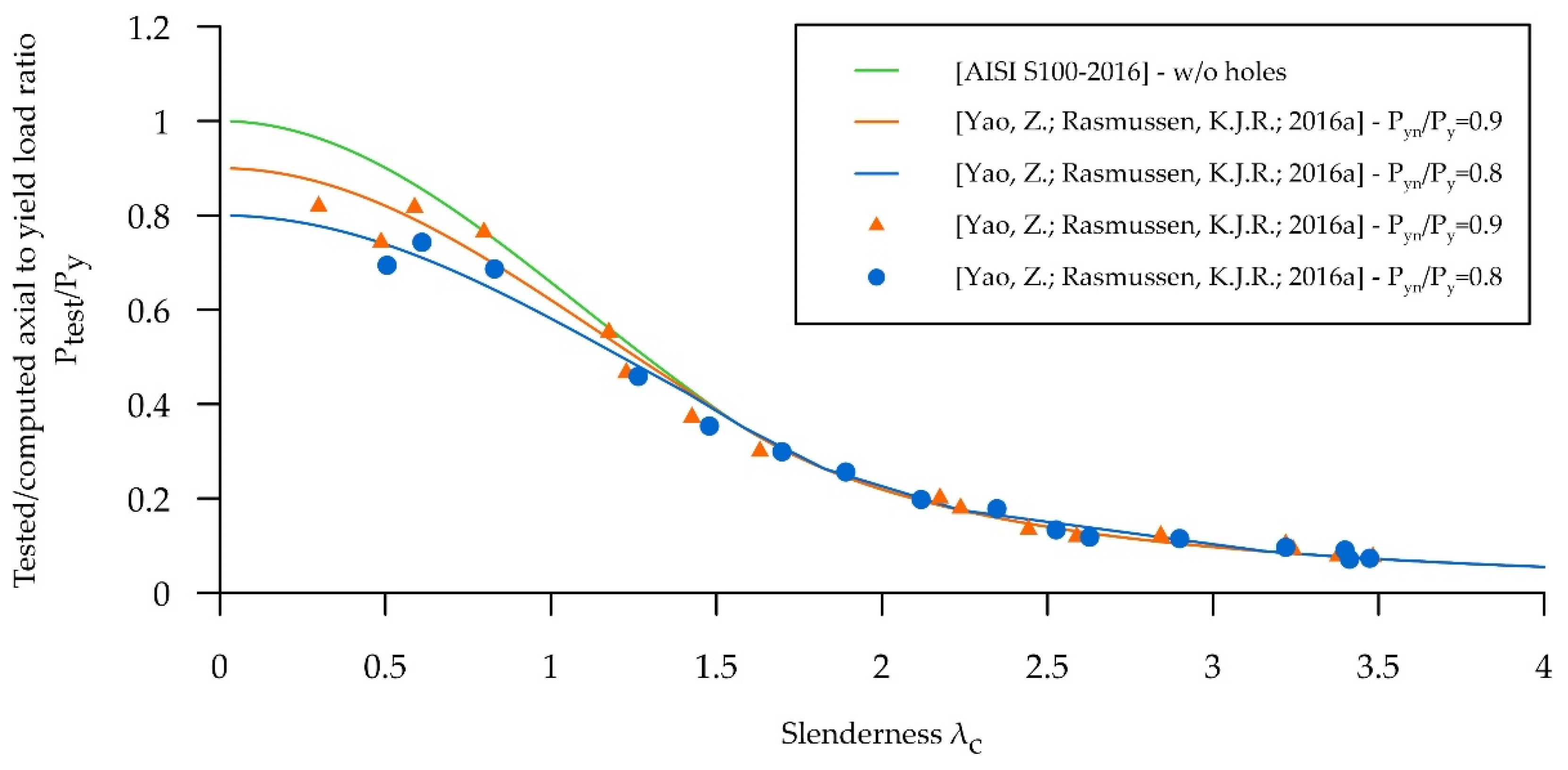
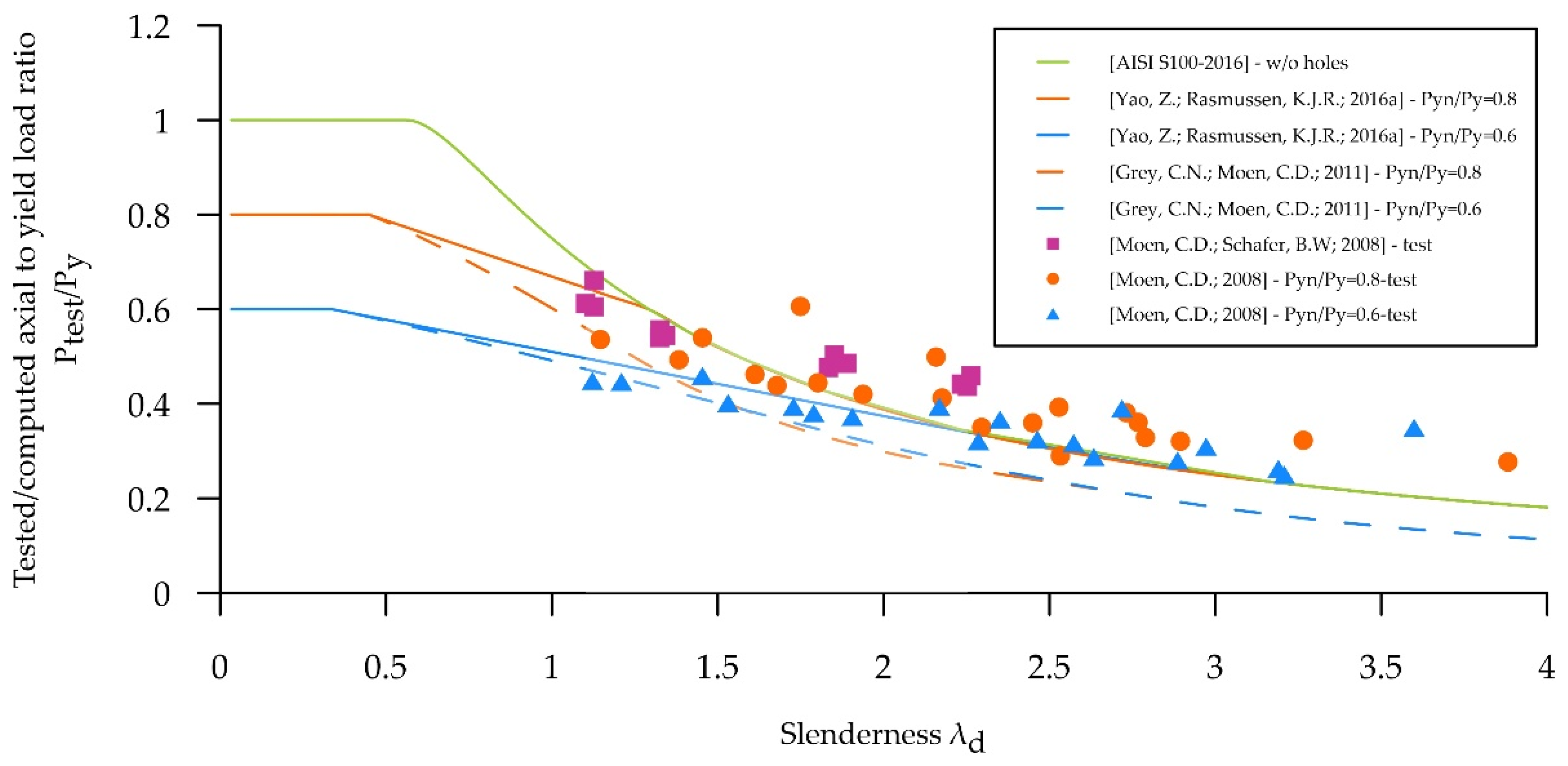
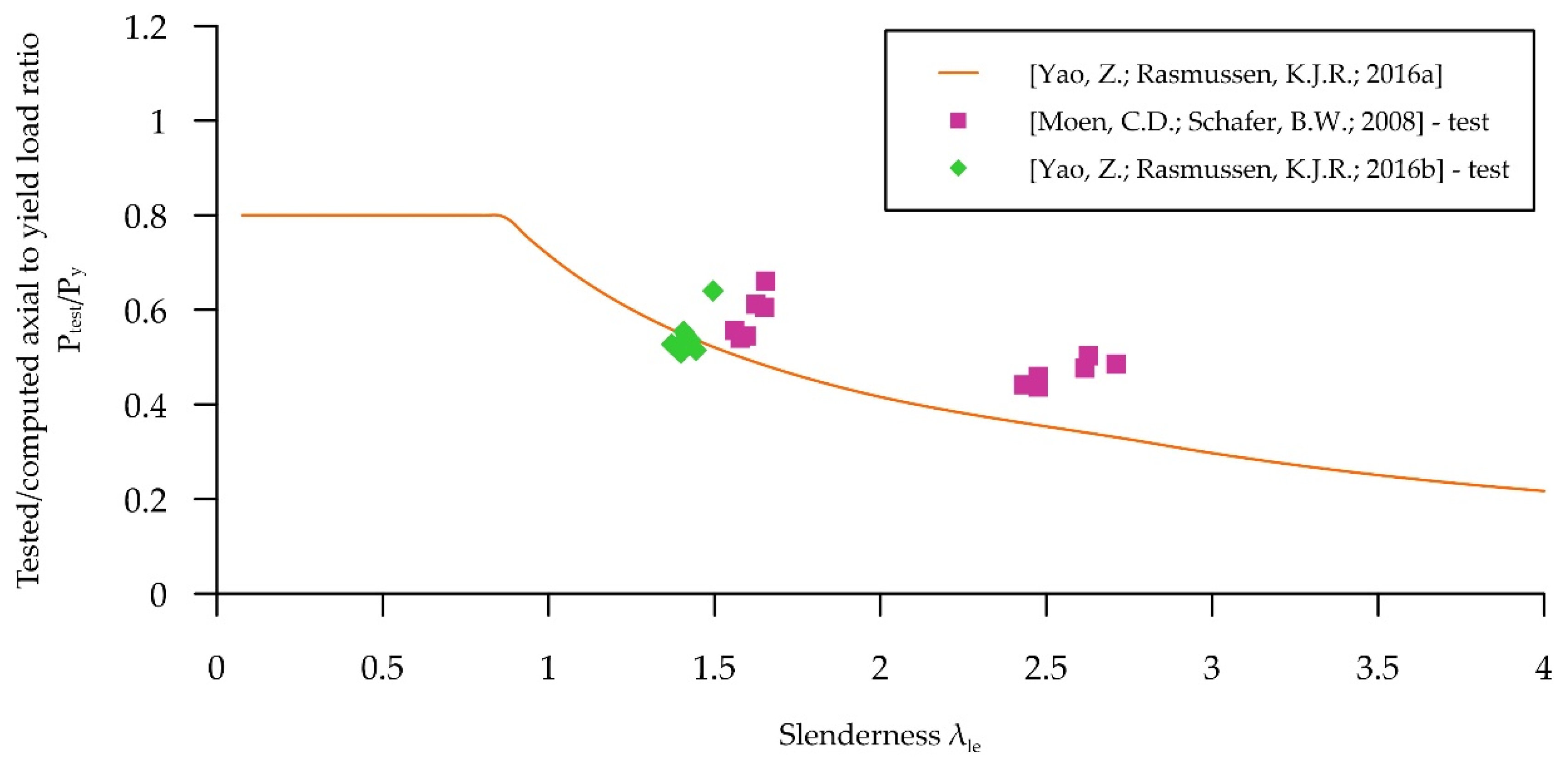
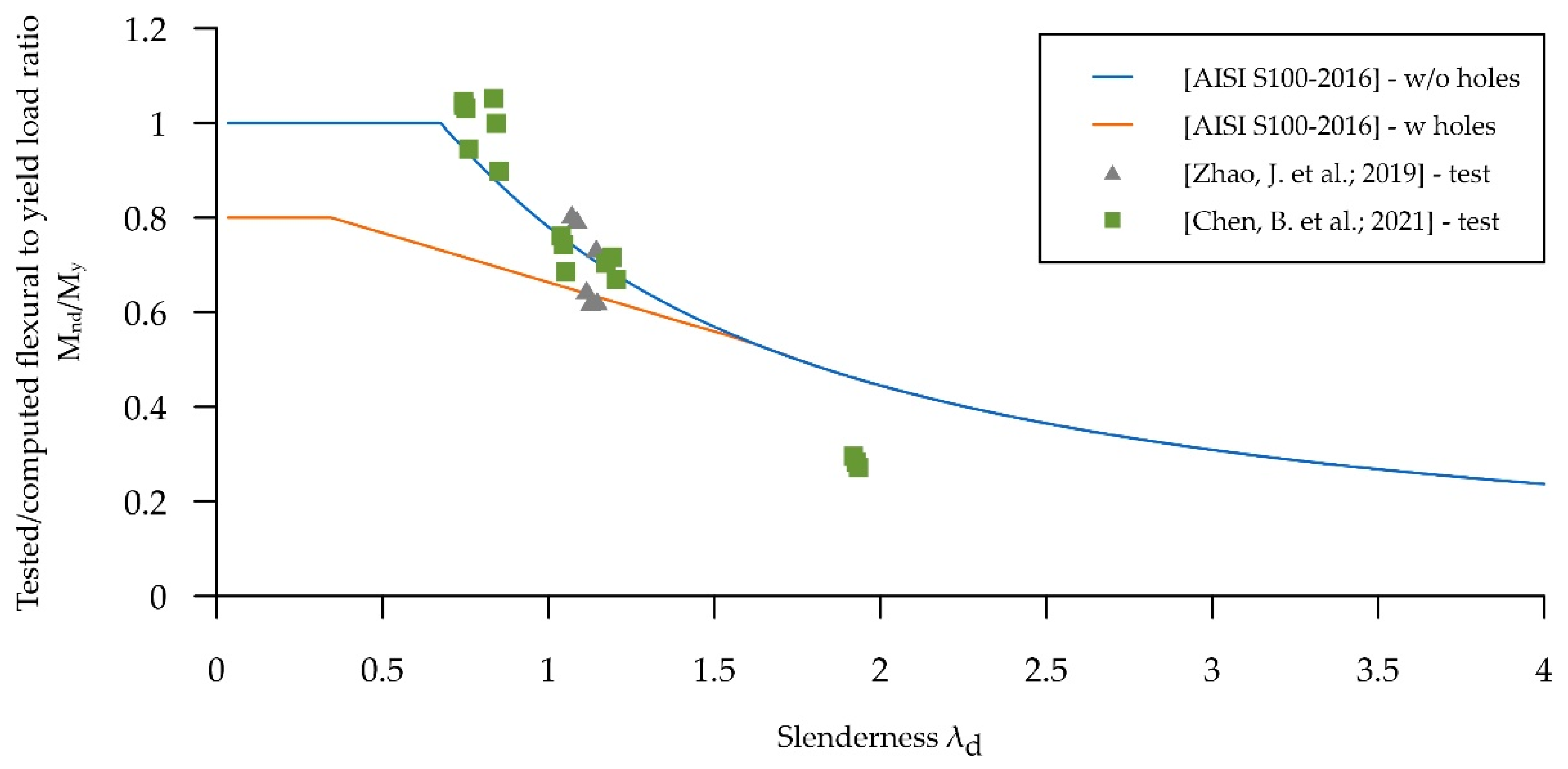


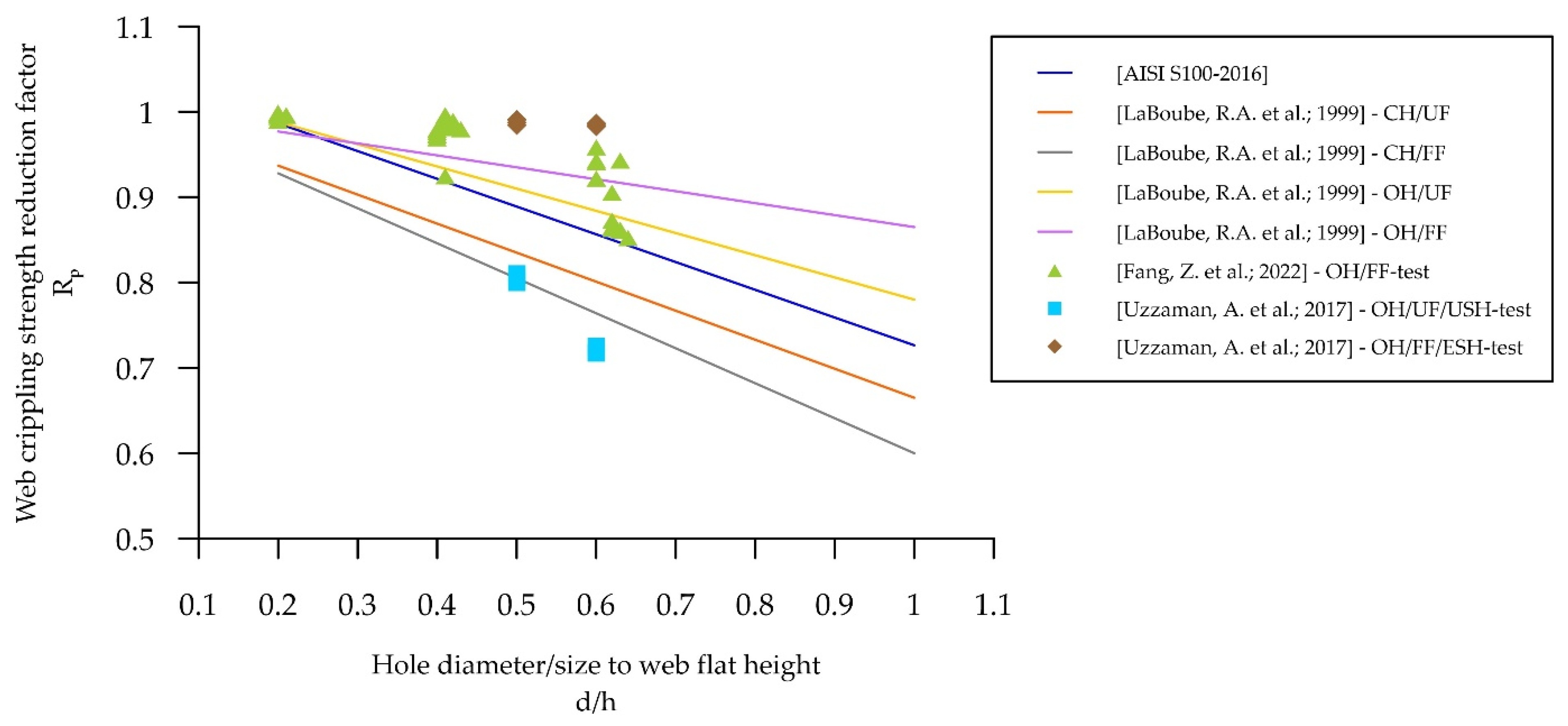
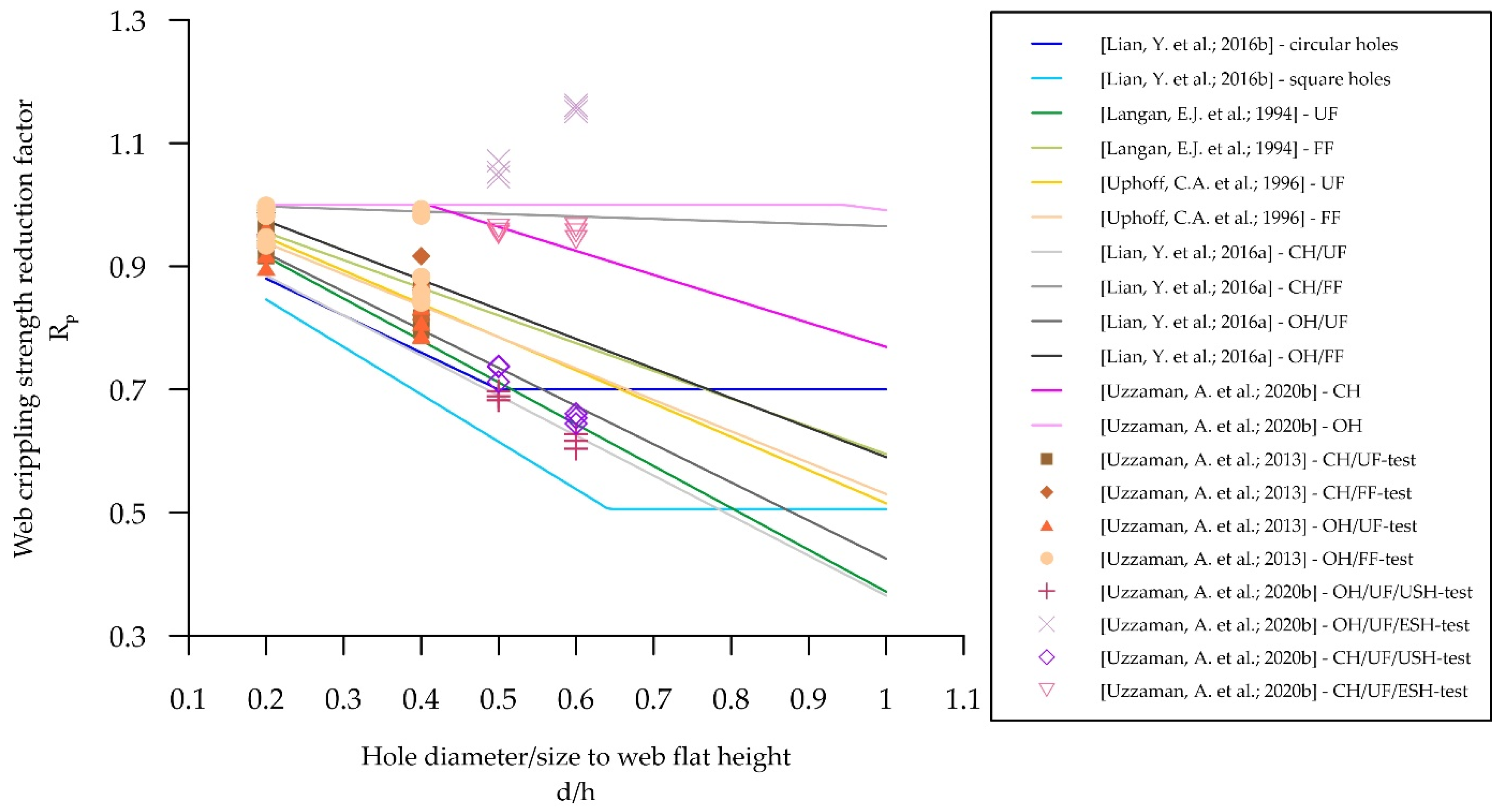

Publisher’s Note: MDPI stays neutral with regard to jurisdictional claims in published maps and institutional affiliations. |
© 2022 by the authors. Licensee MDPI, Basel, Switzerland. This article is an open access article distributed under the terms and conditions of the Creative Commons Attribution (CC BY) license (https://creativecommons.org/licenses/by/4.0/).
Share and Cite
Živaljević, V.; Jovanović, Đ.; Kovačević, D.; Džolev, I. The Influence of Web Holes on the Behaviour of Cold-Formed Steel Members: A Review. Buildings 2022, 12, 1091. https://doi.org/10.3390/buildings12081091
Živaljević V, Jovanović Đ, Kovačević D, Džolev I. The Influence of Web Holes on the Behaviour of Cold-Formed Steel Members: A Review. Buildings. 2022; 12(8):1091. https://doi.org/10.3390/buildings12081091
Chicago/Turabian StyleŽivaljević, Vladimir, Đorđe Jovanović, Dušan Kovačević, and Igor Džolev. 2022. "The Influence of Web Holes on the Behaviour of Cold-Formed Steel Members: A Review" Buildings 12, no. 8: 1091. https://doi.org/10.3390/buildings12081091








